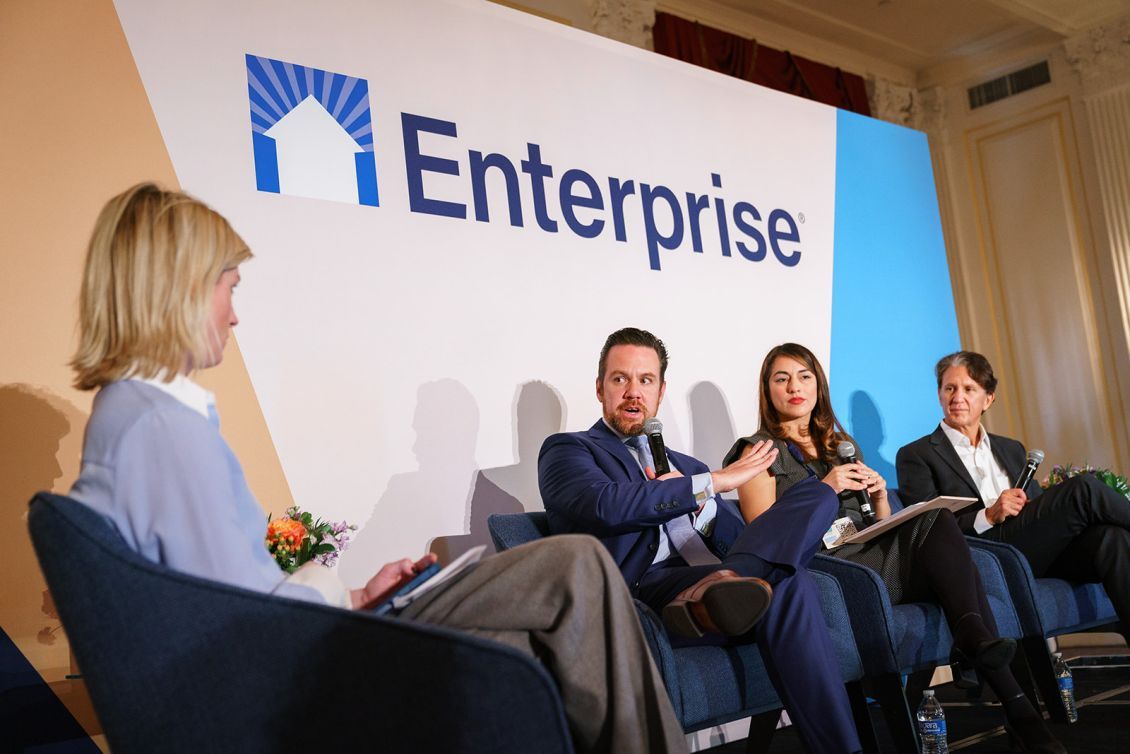Housing is the single biggest driver of inflation, the heaviest expense for most renters and owners each month, and a topic of conversation at kitchen tables across the country. So why aren’t political candidates talking more about housing and the affordable housing crisis?
That was a central question when experts gathered in Washington, D.C., on October 20 to talk about the impact of midterm elections on the housing landscape as part of Enterprise’s 40th anniversary celebration.
The panel, led by Politico reporter Katy O’Donnell, included: former member of Congress Rick Lazio, Enterprise’s incoming board chair and Senior Vice President, alliantgroup and counsel for Jones Walker LLP; Jonathan Kott, partner at Capitol Counsel, LLC; and Noerena Limón, former executive vice president at the National Association of Hispanic Real Estate Professionals and housing fellow for the UC Berkeley Terner Center for Housing Innovation.
The panelists agreed that the election would be tight, and that we can expect a certain amount of gridlock – with no clear mandate for housing. “In either scenario, there’s no mandate,” said Limón, as the other panelists nodded in agreement. “Everybody knows the appreciation of rents and housing prices are off the roof and there’s a housing shortage, but nobody agrees on how to address it.”
The most important races to watch, panelists agreed, include those in Nevada and Georgia, where the incumbents sit on the Senate Banking Committee and have built strong relationships with housing advocates.
The wide-ranging discussion also looked beyond the midterms, focusing on areas for political consensus post-election, as well as ways to encourage more national dialogue around key housing issues.
Here are four key policy themes to watch as midterms approach and beyond, according to the panelists:
- All politics is local: Advancing affordable housing policy may be slow from a national point of view, but policy leaders at state and local levels are starting small and making significant progress. California, for example, has developed “one of the best coalitions” when it comes to zoning reform and housing production, Limón said. “California started small with ADUs [accessory dwelling units] first,” she added. “The way we framed it in California was, who are you to tell me what I’m going to do with my personal property?” With the right players and infrastructure in place, she said, the state was able to pass SB 9, which allows for most single-family homes to build up to four units. Meanwhile, Lazio said that Miami mayor Francis Suarez, a Republican, has been a strong advocate for affordable housing. “Getting down to the local level is really important,” Capitol Counsel’s Kott added. “Not only do I think that’s where the most impact can be made, but once you have advocates there, those are the people who then come to Washington 10 to 15 years later. Now they’re built-in advocates.”
- Finding the words: When it comes to talking about affordable housing, “we have to develop a message that voters understand and that will motivate them because it’s something they can relate to,” Lazio said. “We’re struggling with the words that will resonate with voters and we need to coordinate much better and organize much better in order to get there.” Other panelists agreed that even the term “affordable housing” can be perceived as negative and that the sector needs to find better ways to communicate on the issue. “As housers, we haven’t figured out how to communicate on housing in a way that dispels the fear and unites people as opposed to dividing them,” Limón said.
- Crossing the aisle: Despite the polarized national political landscape, panelists pointed to some areas where there is increased bipartisan support for affordable housing policies and initiatives. “I do think in a divided government, this is one of those pocketbook issues that you could see some compromise on,” Kott said. Areas for ongoing and future bipartisan compromise mentioned included: the need for zoning reform; expanding the Low-Income Housing Tax Credit, giving the USDA the authority and flexibility and resources to preserve affordable and multifamily housing; and finding solutions for building more affordable housing in rural communities and on Tribal lands
- A business opportunity: Across the country, workers are having trouble finding affordable housing, a situation that creates an opportunity for more political discourse and policy support. In West Virginia, for example, the American Federation of Teachers partnered with Teach for America to bring more teachers to the area, but lack of affordable housing got in the way. “There was no place for teachers to rent or live,” Kott said. And in Northern California, tech giants including Apple and Google are investing in affordable housing, because “it’s a business imperative to have a place where their workers can live,” Lazio said. “Explaining that affordable housing is also an economic development opportunity is a way to message affordable housing in a way more people can connect with.”
To stay up to date on the midterm elections and their impact on housing, subscribe to Enterprise’s Today in Housing and Capitol Express newsletters.

